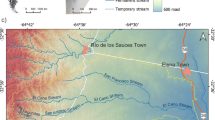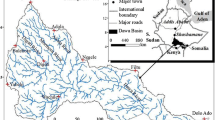Abstract
A strong geochemical gradient was observed in the thick overburden aquifer of the Asa drainage basin. Different types of groundwater occur at different (downslope) locations and groundwater table depths. The following sequence was noticed with increasing distance downslope or with increasing groundwater table depth:
1. Ca–Mg–HCO3 water at about 390-m groundwater table elevations or upslope locations.
2. Ca–Mg–HCO3–Cl water at middle-slope locations or groundwater table elevations of about 350 m above sea level;
3. Ca–Mg–SO4–Cl water at downslope locations or groundwater table elevations of about 300 m above sea level.
In this basin, changes in the type of water are expected at about every 40–50 m depth from the surface. Statistical analysis via the determination of the correlation coefficient (r) and regression analysis shows that about 80–99% of the variation in groundwater chemistry is accounted for by the topography, using the model presented in this paper. The rate of change in the sequence will depend on the permeability of the aquifer, which determines the rate of groundwater flow and the residence time, and the nature of recharge.
Similar content being viewed by others
Author information
Authors and Affiliations
Additional information
Received: 4 February 1997 · Accepted: 22 July 1997
Rights and permissions
About this article
Cite this article
Raji, B., Alagbe, S. A topo-geochemical sequence study of groundwater in Asa drainage basin, Kwara State, Nigeria. Environmental Geology 39, 544–548 (2000). https://doi.org/10.1007/s002540050465
Issue Date:
DOI: https://doi.org/10.1007/s002540050465




